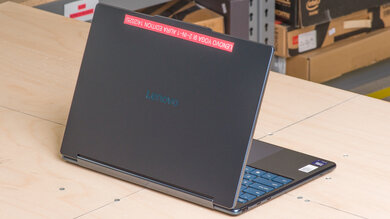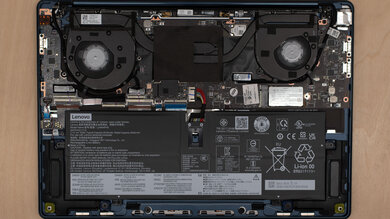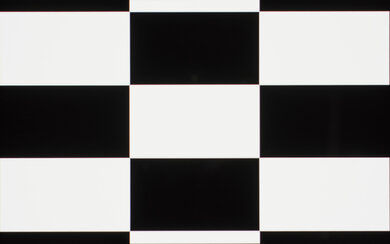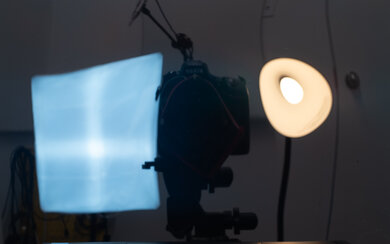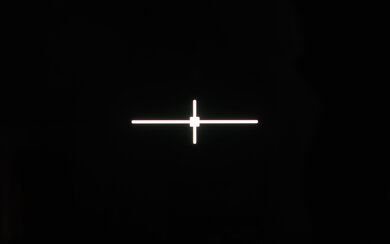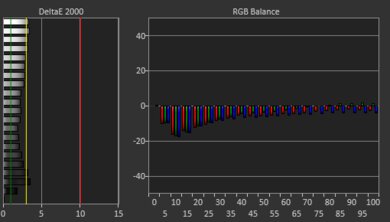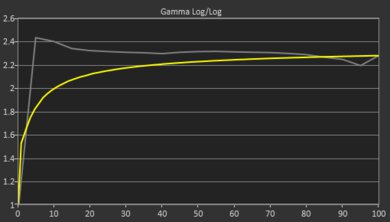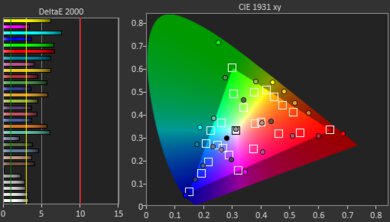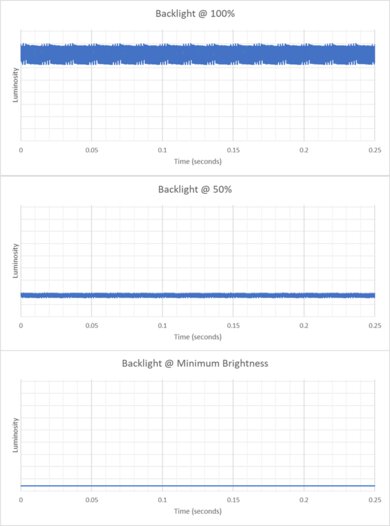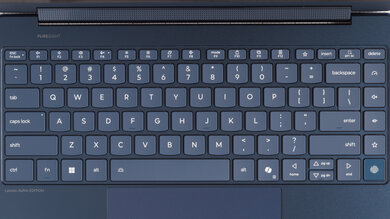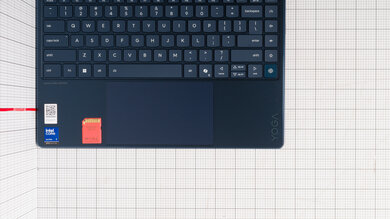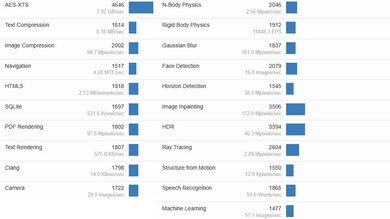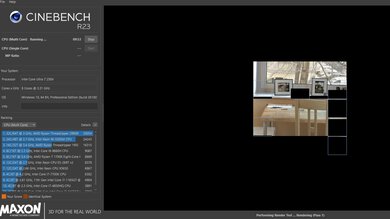The Lenovo Yoga 9i 2-in-1 Aura Edition 14 (2025) is a premium Windows convertible laptop, replacing the Lenovo Yoga 9i 2-in-1 from 2024 (model 14IMH9). This 2025 model is configurable with an Intel Core Ultra 7 256V or 258V SoC and up to 1TB of storage. Display options include a 120Hz 2.8k or a 60Hz 4k+ OLED panel—both support touch and pen input. You get a 1440p webcam with a physical privacy shutter, Wi-Fi 7 wireless connectivity, as well as a Windows Hello facial recognition camera and a fingerprint sensor for biometrics. Ports comprise three USB-Cs (two with Thunderbolt 4 support), a USB-A, and a headphone jack.
See our unit's specifications and the available configuration options in the Differences Between Variants section.
Note: We performed the productivity benchmarks, gaming benchmarks, thermals and noise, and performance over time tests using the Best Performance mode instead of the default Balanced mode. This change makes the results more representative of the laptop's maximum potential and brings them closer to user expectations. However, this also means that the results are only comparable with reviews containing this disclaimer, as we previously tested laptops in their default mode, which usually throttles performance to prolong battery life.
Our Verdict
The Lenovo Yoga 9i 2-in-1 Aura Edition is excellent for school use. It's easy to carry, thanks to its compact design, and its battery lasts easily through a typical school day. The overall user experience is excellent, as it has a nice display with touch and pen input support, a comfortable keyboard, a large touchpad, and a sharp 1440p webcam. The OLED panel doesn't deal with bright reflections very well, so visibility can be an issue in well-lit settings. Performance-wise, Intel SoC can easily handle general productivity workloads like web browsing, text processing, and video playback. You can do some moderately intensive tasks like programming and photo editing, but for highly demanding workloads like 3D animation or simulations, it's best to get a workstation or gaming laptop with a more powerful CPU and discrete GPU.
Easy to carry.
All-day battery life.
Amazing user experience thanks to high-quality display, comfortable keyboard, and responsive touchpad.
Good port selection.
CPU and integrated GPU can't handle demanding workloads.
OLED is susceptible to permanent burn-in.
The Lenovo Yoga 9i 2-in-1 Aura Edition isn't designed for gaming. Its Lunar Lake SoC struggles to push consistent frame rates in demanding games. You can play some light or well-optimized games, but you'll have to play with low graphical settings. The 2.8k OLED display has a 120Hz refresh rate and a decent response time; however, it doesn't support FreeSync or G-SYNC, meaning you'll still see some screen tearing. In short, this laptop is fine for casual gaming, but it isn't ideal if your primary goal is to play games.
120Hz display with decent response time.
Doesn't get hot or loud under load.
User-replaceable SSD.
CPU and integrated GPU can't handle demanding AAA titles.
Significant thermal throttling under load.
The Lenovo Yoga 9i 2-in-1 Aura Edition is excellent for media consumption. It's very portable, thanks to its thin and light design, and since it's a convertible, you can set it in tent mode when viewing content or use it as a tablet. Both its 2.8k and 4k+ OLED displays look sharp and colorful, and they produce deep, inky blacks, making them fantastic for dark room viewing and HDR content. The only downside is that the display's glossy finish struggles with bright reflections, so visibility can be an issue in well-lit environments. The speakers get very loud, and they sound well-balanced, with a good amount of bass. Its battery life is outstanding at around 15 hours of local video playback, giving you plenty of time to get through multiple movies and TV show episodes.
Easy to carry.
All-day battery life.
Sharp, colorful display.
OLED display produces deep blacks for better dark room viewing experience.
Can use in tent mode or as a tablet.
OLED is susceptible to permanent burn-in.
The Lenovo Yoga 9i 2-in-1 Aura Edition isn't designed for use as a workstation. Its Intel Lunar Lake SoC can only handle light to moderately demanding tasks. Plus, you can only get up to 32GB of soldered RAM, which isn't enough for highly intensive workloads. You can do some color-correction work, as its OLED displays have full DCI P3 and near-full Adobe RGB coverage. It has a fast, user-replaceable SSD and a good port selection that includes two Thunderbolt 4 ports. The laptop doesn't get hot or loud under load, but there's considerable thermal throttling on the CPU and GPU, causing inconsistent performance.
Doesn't get hot or loud under load.
User-replaceable SSD.
Good port selection.
Display is suitable for color-critical work.
CPU and integrated GPU can't handle demanding workloads.
Significant thermal throttling under load.
Can only get up to 32GB of soldered RAM.
OLED is susceptible to permanent burn-in.
The Lenovo Yoga 9i 2-in-1 Aura Edition is great for business use. It has a premium, sturdy build, a compact design, and amazing battery life, making it well-suited for those who travel a lot for work. It also provides an excellent user experience thanks to its sharp OLED display, spacious keyboard, large touchpad, and 1440p webcam. You get a fingerprint sensor and a facial recognition IR camera, so you can log in quickly and get straight to work. Performance is great; its Intel SoC can easily handle productivity tasks like text processing, web browsing, spreadsheets, and presentations. OLED displays are susceptible to permanent burn-in, so you'll want to take active measures to prevent it if you plan to keep the laptop for a while, like hiding Windows' taskbar.
Easy to carry.
All-day battery life.
Amazing user experience thanks to high-quality display, comfortable keyboard, and responsive touchpad.
Excellent 1440p webcam.
Good port selection.
OLED is susceptible to permanent burn-in.
Changelog
-
Updated Aug 25, 2025:
Added mention of the ASUS Zenbook DUO UX8406 14 (2025) as a dual-screen alternative in the Screen Specs section.
- Updated May 07, 2025: We've updated this review to Test Bench 0.8.3, which removes the viewing angle tests and adds a GPU Total Graphics Power comparison in the GPU section. The Pen Input test in the Extra Features section has also changed, as it now shows whether the laptop supports pen input rather than the inclusion of a stylus in the box. See the changelog for more details.
- Updated Apr 30, 2025: Review published.
- Updated Apr 22, 2025: Early access published.
Check Price
Differences Between Sizes And Variants
We tested the Lenovo Yoga 9i 2-in-1 Aura Edition (model/type: 14ILL10/83LC0005US) with a 120Hz 2.8k OLED display, an Intel Core Ultra 7 258V SoC, and 1TB of storage. The display, SoC, and storage are configurable; see below for the available options.
SCREEN
- 14" OLED 2880 x 1800 120Hz (glossy, touchscreen, 100% DCI P3)
- 14" OLED 3840 x 2400 60Hz (glossy, touchscreen, 100% DCI P3)
SoC
- Intel Core Ultra 7 256V (8 cores/8 threads, up to 4.8GHz, 12MB cache, Arc Graphics 140V, 16GB RAM)
- Intel Core Ultra 7 258V (8 cores/8 threads, up to 4.8GHz, 12MB cache, Arc Graphics 140V, 32GB RAM)
MEMORY
- 16GB LP-DDR5x 8533MHz (Core Ultra 7 256V only)
- 32GB LP-DDR5x 8533MHz (Core Ultra 7 258V only)
STORAGE
- 512GB M.2 2242 PCIe Gen 4 NVMe SSD
- 1TB M.2 2242 PCIe Gen 4 NVMe SSD
COLOR
- Cosmic Blue
- Luna Gray
See our unit's label.
Popular Laptop Comparisons
The Lenovo Yoga 9i 2-in-1 Aura Edition is an excellent Windows convertible laptop and among the best in its class. It provides a similar user experience to direct competitors like the HP OmniBook Ultra Flip 14 (2024). The Yoga's USB-A port makes it a little more convenient, as many peripherals still use a USB-A connector, and its battery life is significantly better, lasting around three hours longer in light uses. One downside, or perhaps a missed opportunity, is that it still uses a diving board touchpad, whereas most premium laptops in its class have adopted haptic touchpads.
For more options, check out our recommendations for the best 2-in-1 laptops, the best Windows laptops, and the best laptops for college.
The Lenovo Yoga 9i 2-in-1 Aura Edition 14 (2025) and the ASUS Zenbook DUO UX8406 14 (2025) are both premium convertible laptops; however, the Yoga only has one screen, while the Zenbook has two. The Zenbook DUO is obviously the better choice if you need the second screen, but remember that running both displays will significantly impact battery life. You get better CPU performance on the Zenbook DUO; however, the Yoga delivers a better overall user experience, as it has a higher quality webcam, better-sounding speakers, and lower fan noise.
The Lenovo Yoga 9i 2-in-1 Aura Edition 14 (2025) and the HP OmniBook Ultra Flip 14 (2024) are both 14-inch convertibles that provide a similar user experience overall. The choice depends on what you care about most; the Yoga has a longer battery life and a USB-A port, while the OmniBook has an easier-to-use haptic touchpad and a better webcam. You can get the Yoga with a sharper 4k+ OLED display, whereas the OmniBook is only available with a 2.8k panel; however, remember that the increased resolution will drain the battery faster.
The Lenovo Yoga 9i 2-in-1 Aura Edition 14 (2025) and the Samsung Galaxy Book5 Pro 360 (2024) are both premium convertibles with Intel Lunar Lake SoCs. Choosing between these two laptops depends on your size preference and the features you care about most; the Lenovo is more portable since it's a smaller device, and it also has better speakers, a higher-quality webcam, and longer battery life. On the other hand, the Samsung has an HDMI port, which might be more convenient if you frequently connect an external display, and its numpad is handy for those working with lots of numbers. If you're sensitive to display flicker, the Lenovo might be a better choice since its OLED's flicker frequency is well above 1000Hz and less likely to cause eye strain compared to the Samsung's OLED panel, which flickers at 120Hz.
The Lenovo Yoga 9i 2-in-1 Aura Edition 14 (2025) is better than the Lenovo Yoga 7 2-in-1 14 (2024) for most uses. The Yoga 9i is essentially a more premium sibling with a sturdier, more premium build, higher quality display options, a better webcam, and a longer battery life. That said, you can get better multi-thread performance out of the Yoga 7, especially if you get a model with the higher-end AMD Ryzen 7 CPU.
Test Results
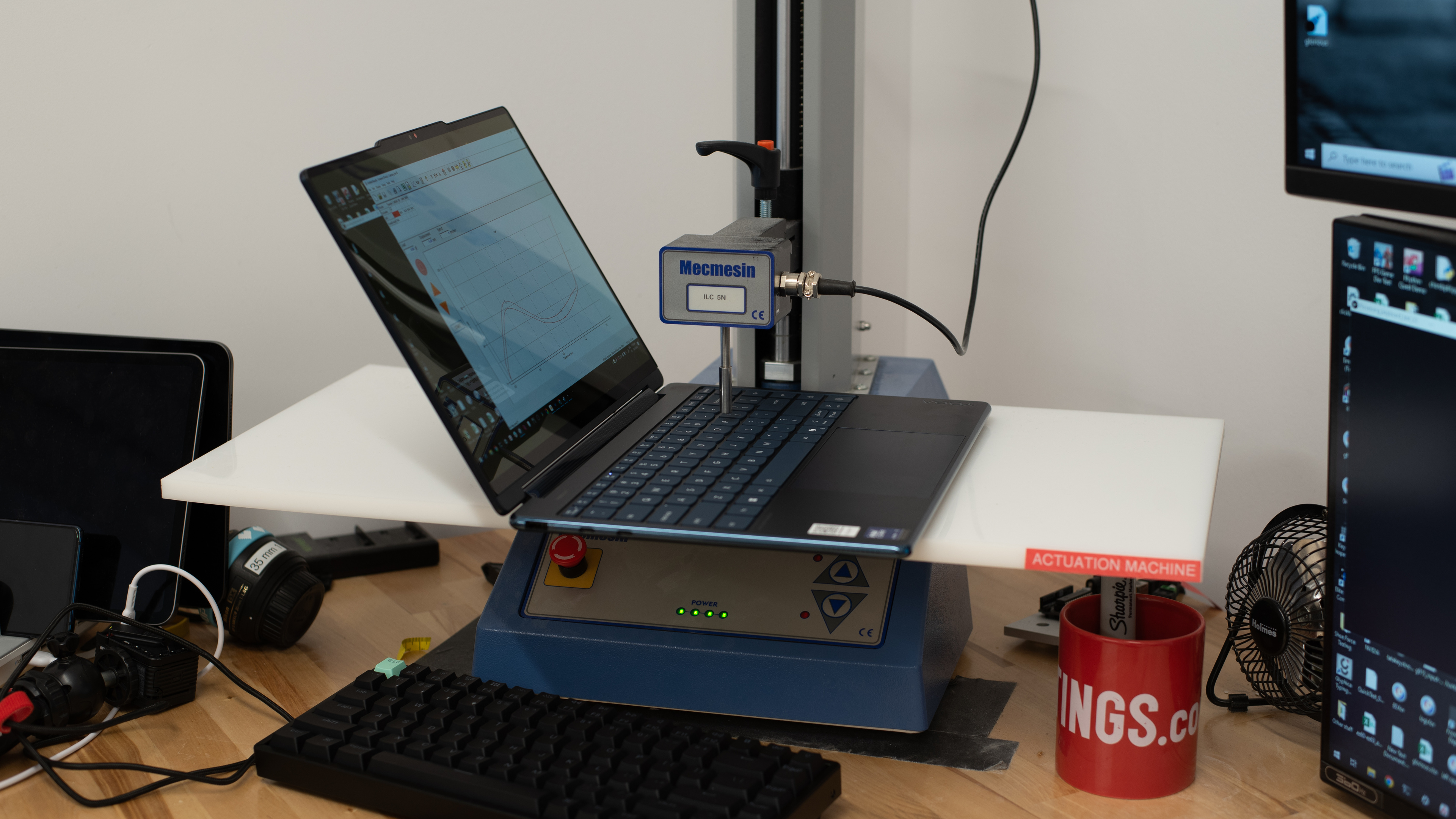
The Lenovo Yoga 9i 2-in-1 Aura Edition is available in a Cosmic Blue or Luna Gray colorway. See the bottom of the laptop.
The Lenovo Yoga 9i 2-in-1 Aura Edition's build quality is outstanding. Its all-aluminum chassis feels very sturdy, exhibiting only some flex on the lid and almost none on the keyboard deck. The display doesn't twist when manipulating it; it's worth noting that the panel is slightly warped, though the warping doesn't affect regular use and is unlikely to be an issue in terms of durability. The finish doesn't scratch easily, and while it picks up some fingerprints and smudges, it isn't nearly as bad as most laptops with a dark-color finish. There are no complaints with the feet—they feel solid and stick firmly to the bottom.
The Lenovo Yoga 9i 2-in-1 Aura Edition's hinge feels solid. It's quite stiff, requiring a fair amount of effort to open the lid or adjust the tilt. However, this is typical of 2-in-1 convertibles, as it prevents the laptop from collapsing when using it in tent mode. The screen doesn't wobble when typing heavily. Using touch input doesn't cause much wobbling either, as long as you aren't pressing too hard on the screen.
Accessing the internals is relatively easy; you only need to remove four T5 screws and use a prying tool to release the bottom panel's clips. Undoing the clips does take some effort, so you must be careful to avoid breaking them. The storage slot supports M.2 2242 PCIe Gen 4 NVMe SSDs.
Download the hardware maintenance manual here.
The Lenovo Yoga 9i 2-in-1 Aura Edition is available with the following displays:
- 14" OLED 2880 x 1800 120Hz (glossy, touchscreen)
- 14" OLED 3840 x 2400 60Hz (glossy, touchscreen)
Both panels look very sharp, with the lower-resolution 2.8k even exceeding the pixel density of the Apple MacBook Air 13 (M4, 2025)'s Retina display. The 4k+ panel looks sharper, but the difference might not be immediately noticeable on a 14-inch screen at typical viewing distance. Also, keep in mind that the increased resolution will drain the battery faster. The 16:10 aspect ratio is great for productivity, as the increased vertical space in landscape mode lets you see more information at once when reading a document (compared to a 16:9 display). However, some may find 16:10 a little too narrow when using the device as a tablet in portrait mode, as most people are more accustomed to the Apple iPad's 4:3 or the Microsoft Surface Pro's 3:2 aspect ratios. OLEDs are susceptible to permanent burn-in, so you'll want to take active measures to prevent it, like hiding Windows' taskbar. If you need a lot of screen space, check out the ASUS Zenbook DUO UX8406 14 (2025), a dual-screen laptop with a kickstand and detachable keyboard.
The Lenovo Yoga 9i 2-in-1 Aura Edition is available with a 2.8k 120Hz or a 4k+ 60Hz OLED display. The 120Hz panel provides a better user experience than the 60Hz display, as it makes motion look smoother and improves input responsiveness. However, setting the refresh rate to 120Hz will drain the battery faster. You can set it to a fixed 60Hz to save battery or activate Dynamic Refresh Rate, which will vary the refresh rate between 30Hz and 120Hz, depending on whether you're actively using the laptop or looking at static content. Dynamic Refresh Rate isn't the same as FreeSync or G-SYNC, so you may still see some screen tearing when gaming with an uncapped frame rate. As for the response time, this isn't the fastest 120Hz OLED panel, but it's better than most IPS panels on productivity laptops. The 60Hz 4k+ panel is likely slower, resulting in slightly more ghosting in fast-moving scenes.
The Lenovo Yoga 9i 2-in-1 Aura Edition's 2.8k display gets bright enough for use in most indoor settings, though it doesn't get anywhere close to the advertised 500 cd/m² in SDR. It gets very dim at the lowest brightness setting, which can help reduce eye strain when viewing content in the dark.
Lenovo specifies that the 2.8k panel can reach a max brightness of 1,100 cd/m² in HDR. It doesn't quite get there, but it's pretty close. Here are the measurements:
- 2% window: 637.6 cd/m²
- 5% window: 914.1 cd/m²
- 10% window: 946.5 cd/m²
- 25% window: 938.2 cd/m²
- 50% window: 907.6 cd/m²
- 100% window: 625.1 cd/m²
The 4k+ panel has an advertised peak brightness of 400 cd/m² in SDR and 600 cd/m² in HDR.
The display's glossy finish struggles with bright light sources, like a lamp or open window during the day. These reflections are visible even when viewing light-color content with the screen at maximum brightness. The 4k+ panel has the same glossy finish and will perform identically.
Note: The reflections in the photos look warped because the screen itself is warped, as noted in the Build Quality section.
The 2.8k display is reasonably accurate out of the box. The overall white balance is pretty good, with only the lightest and darkest grays being visibly off. This model's single preset color profile (LEN140WQ+ Standard) targets a wider color space, causing oversaturation. Some people might prefer this over-saturated look; just know it isn't accurate. The gamma is too high in nearly all scenes, making them too dark and crushing blacks.
The 2.8k display has an outstanding color gamut. It has full coverage of the sRGB and DCI P3 color spaces, as well as near-full coverage of the Adobe RGB color space. This panel is suitable for general media consumption, as well as color-critical work like photo and video editing. The 4k+ panel has the same advertised color gamut.
The Lenovo Yoga 9i 2-in-1 Aura Edition has a great keyboard. Its layout feels spacious and is easy to get used to. The keys are very stable, except for the Space Bar and the additional keys on the right, which wobble slightly. As for the typing experience, the keys could use a tad more travel and tactility, but this is otherwise a very comfortable keyboard to type on for long periods. You can adjust the backlight brightness using FN + Space Bar—the backlight shines well through the legends.
The Lenovo Yoga 9i 2-in-1 Aura Edition has an excellent touchpad. It's large and responsive to all movements and gestures. Palm rejection works as intended, and there are no issues with actions like dragging and dropping or zooming in and out of images. This is a diving board touchpad with mechanical buttons, so you can only click in the bottom half of the touchpad. The clicking mechanism works well, but feels a little flimsy and mushy.
The Lenovo Yoga 9i 2-in-1 Aura Edition has excellent speakers. Built into the hinge, they fire at you when using the laptop in clamshell mode and sideways in tablet mode. They get very loud with minimal compression artifacts at high volume levels, and they sound well-balanced, with great spatial imaging and instrument separation.
The Lenovo Yoga 9i 2-in-1 Aura Edition has an excellent webcam. The image looks sharp and detailed, with only a small amount of noise in the background. Colors look true to life, though the color temperature is a tad too cold. Voices sound clear over the microphone, but over-processed. The privacy cover is only a physical barrier, meaning the microphone can still record audio; you can disable the microphone separately using the F4 shortcut.
The Lenovo Yoga 9i 2-in-1 Aura Edition has a good port selection. The USB-A port supports USB 3.2 Gen 2 data transfer speed of up to 10Gbps and is always on, meaning you can use it to charge a mobile device even when the laptop is in sleep mode. All three USB-Cs support Power Delivery 3.0. However, the two on the left side of the laptop support DisplayPort 2.1 and Thunderbolt 4 data transfer speed of up to 40Gbps, while the one on the right supports DisplayPort 1.4 and USB4 Gen 2x2 data transfer speed of up to 20Gbps.
The Lenovo Yoga 9i 2-in-1 Aura Edition's wireless adapter is an Intel Wi-Fi 7 BE201. Like Wi-Fi 6E, Wi-Fi 7 gives you access to the 6GHz band but with even faster speeds and lower latency. However, you need a router that supports Wi-Fi 7 to benefit from these features. Check out our best router recommendations if you want to upgrade your wireless setup.
The Lenovo Yoga 9i 2-in-1 Aura Edition is available with the following SoCs:
- Intel Core Ultra 7 256V (8 cores/8 threads, up to 4.8GHz, 12MB cache, Arc Graphics 140V, 16GB RAM)
- Intel Core Ultra 7 258V (8 cores/8 threads, up to 4.8GHz, 12MB cache, Arc Graphics 140V, 32GB RAM)
Both are low-power chips designed for general productivity tasks like web browsing, text processing, spreadsheets, and video playback. Unlike their Meteor Lake predecessors, these Lunar Lake processors are proper SoCs (System on Chip) with the RAM built in. The 256V and the 258V are the same chip with identical clock speeds and core composition (four performance and four efficiency). The only difference is their memory size—16GB and 32GB, respectively—so the choice really comes down to the amount of RAM you need for your workload. Another change is the lack of Hyper-Threading, resulting in slightly slower multi-thread performance compared to Meteor Lake CPUs. These SoCs have an NPU (Neural Processing Unit) with a rated performance of 47 TOPS (Trillions of Operations per Second) to handle AI tasks, like Windows Copilot, image generation in photo editing apps, and background-blurring on video calls.
The Lenovo Yoga 9i 2-in-1 Aura Edition is only available with Intel's Arc Graphics 140V, an integrated GPU designed primarily for light productivity tasks. The 140V is a nice step up from the GPUs on previous Intel chips, performing close to the discrete, albeit aging, NVIDIA GeForce GTX 1650 (mobile) in synthetic gaming benchmarks. However, as shown in the Performance Over Time section, this laptop suffers from a fair amount of thermal throttling, so don't expect to perform any heavy, sustained tasks.
You can get this laptop with 16GB or 32GB of RAM. However, as mentioned in the CPU section, you can only get 16GB if you get a model with a Core Ultra 7 256V SoC, while 32GB is only available on models with a Core Ultra 7 258V SoC. The RAM isn't user-replaceable.
You can configure this laptop with 512GB or 1TB of storage. The storage is user-replaceable; the slot supports M.2 2242 PCIe Gen 4 NVMe SSD.
The Lenovo Yoga 9i 2-in-1 Aura Edition scores well in the Geekbench 5 benchmarks. The Intel Core Ultra 7 258V SoC's single-thread performance is excellent, sitting near the top of current-gen x86 chips. That said, it lags behind Apple's M4 SoC by a considerable margin of around 35%. As for its multi-thread performance, while it's a step backward compared to the last-gen Intel Meteor Lake CPUs, it's still plenty fast for this laptop's intended use, namely media consumption and general productivity tasks like web browsing, text processing, spreadsheets, and presentations. There are significantly faster CPUs and SoCs on the market if you need more processing power to run heavily multi-threaded applications, like Intel or AMD's HX CPUs and Apple's M4 Pro and Max SoCs.
Regarding the GPU, although the Arc Graphics 140V are a step up from previous generation integrated GPUs, they're still pretty weak compared to discrete GPUs, at least when it comes to non-gaming, computing tasks.
Below are additional benchmark scores in Geekbench 6 in case you're more familiar with those numbers:
- CPU Single-thread: 2,756
- GPU Multi-thread: 11,266
- GPU Compute: 26,821
The Lenovo Yoga 9i 2-in-1 Aura Edition with an Intel Core Ultra 7 258V SoC performs relatively well in the Cinebench R23 benchmarks, at least for an ultraportable with limited cooling. This performance is suitable for light to moderately intensive workloads. There are much faster CPUs on the market if you need to perform highly demanding multi-threaded tasks, like the Razer Blade 18 (2024)'s Intel Core i9-14900HX and the Apple MacBook Pro 16 (2024)'s M4 Max SoC.
Here are additional benchmark numbers from Cinebench 2024 in case you're more familiar with them:
- Single-thread: 127
- Multi-thread: 553
The Intel Core Ultra 7 258V's Arc Graphics 140V's performance in the Basemark GPU benchmark is okay. As mentioned in the GPU section, it can handle some lighter or well-optimized games at 1080p, but you'll have to lower some graphical settings to get playable frame rates, and even then, performance may be inconsistent due to thermal throttling.
Models with a 4k+ display will have a shorter battery life. Lenovo estimates a 3.5-hour decrease in light uses (web browsing at 150 cd/m² screen brightness) and a 7.5-hour decrease in local video playback time (1080p video at 150 cd/m²).
Borderlands 3 runs poorly at 1080p on the Lenovo Yoga 9i 2-in-1 Aura Edition, as the Intel Core Ultra 7 258V SoC's integrated graphics can't handle such a graphically demanding title. While you can get over 60 fps with low settings, the gameplay is very choppy due to frame drops. Lowering the resolution to 720p will likely reduce the stuttering, but won't completely fix it.
Civilization VI and other similar strategy games aren't demanding on the GPU, so getting high frame rates isn't really an issue. The average turn time is decent but not particularly notable, as you can easily find laptops with an older CPU that perform better.
Counter-Strike 2 runs poorly. Although you can get well above 60 fps with low settings, the gameplay is quite choppy due to frame drops, which isn't ideal for an FPS game.
Shadow of the Tomb Raider runs poorly on the Lenovo Yoga 9i 2-in-1 Aura Edition at 1080p. The game stutters a lot, even with low graphical settings. Lowering the resolution to 720p will reduce the stuttering but won't completely fix it.
The Lenovo Yoga 9i 2-in-1 Aura Edition's keyboard deck only gets mildly warm under load. The hinge reaches 44.6 °C (112.28 °F), which isn't really an issue when using the device in laptop mode; however, it may cause some discomfort when holding the device by the side in tablet mode. At 42.7 °C (108.86 °F), the bottom is warm but not uncomfortable.
The posted results are measurements taken in the Performance power mode. You can change the mode to Auto or Battery Saver (with the performance gauge key below Delete) to further reduce heat and fan noise, albeit at the cost of performance.
The Lenovo Yoga 9i 2-in-1 Aura Edition has many pre-installed applications; see this video for the full list.
The Lenovo Yoga 9i 2-in-1 Aura Edition has a Windows Hello facial recognition camera and a fingerprint sensor. You can use either to log in quickly, authorize purchases in the Windows Store, and auto-fill saved passwords on supported websites.
The display supports pen input. Depending on the region and retailer, you may get a Lenovo Yoga Pen included in the box. The Yoga Pen is a Wacom AES stylus with 4096 levels of pressure sensitivity and tilt support. You can use any Wacom AES pen if your model doesn't come with one. The pen is rechargeable via USB-C and attaches magnetically to the laptop's lid.
As for the inking experience, the latency is great, thanks to the display's 120Hz refresh rate, though expect it to be slightly worse on models with a 60Hz 4k+ panel. There's no issue with jitter, and palm rejection works as intended.


